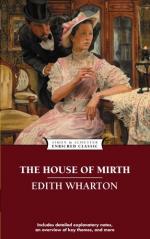|
This section contains 7,229 words (approx. 25 pages at 300 words per page) |

|
SOURCE: Totten, Gary. “The Art and Architecture of the Self: Designing the ‘I’-Witness in Edith Wharton's The House of Mirth.” College Literature 27, no. 3 (fall 2000): 71-87.
In the following essay, Totten suggests that Lily's one genuine moment of subjectivity happens when she constructs herself as the aesthetic figure of Mrs. Lloyd.
“If, then, design is inevitable, the best art must be that in which it is most organic, most inherent in the soul of the subject.”
(Wharton 1914, 229-30)
Maurice Merleau-Ponty, writing of the ideological force of the gaze in The Visible and the Invisible, argues that “we could not dream of seeing [things] ‘all naked’ because the gaze itself envelops them [and] clothes them with its own flesh” (1968, 131). Merleau-Ponty's conception of how the gaze works describes the ideological utility of the eyewitness gaze within the discursive system of late nineteenth- and early twentieth-century American literary Realism.1 Indeed, narratives...
|
This section contains 7,229 words (approx. 25 pages at 300 words per page) |

|


